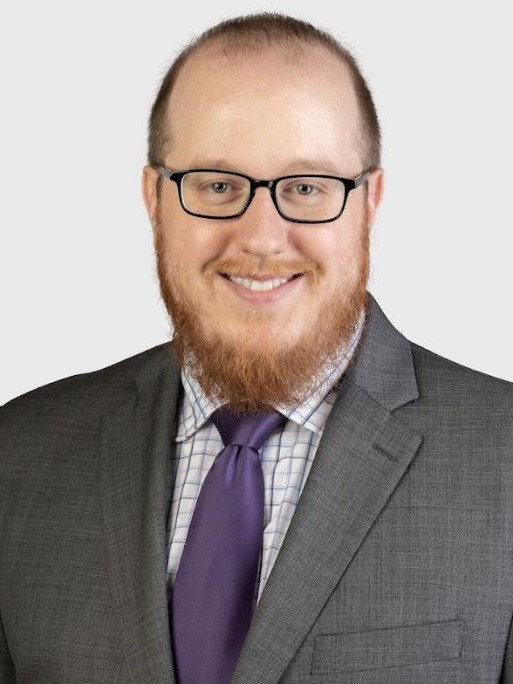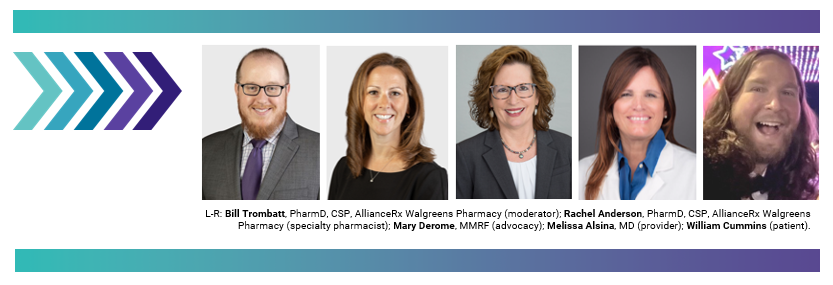Key Takeaways: The Multiple Myeloma Journey

Understanding what a patient with multiple myeloma goes through when diagnosed and managing his or her disease was the focus of a panel discussing at the 2022 PBMI Annual National Conference held in Orlando this year.
During the panel discussion, moderated by William Trombatt, PharmD, CSP, manager of clinical programs at AllianceRx Walgreens Pharmacy, participants heard from several vantage points – including a patient, physician, specialty pharmacist, and advocacy organization – each of whom impacts the journey of a patient with multiple myeloma.
Attendees of the session were able to walk away with a better view of the journey of a patient diagnosed and living with multiple myeloma, and how clinical care teams and patient-advocacy groups provide services during that journey.
Some key takeaways from the panel discussion:
Multiple myeloma is a life-changing diagnosis.
Initial symptoms of multiple myeloma may manifest as general aches and pains. Often, the first sign of multiple myeloma is a broken bone that does not heal as expected after the injury. A cancer diagnosis after an injury is often an unanticipated outcome for patients. After diagnosis, patients often begin a multi-drug treatment regimen and later may undergo a bone marrow transplant. Multiple myeloma is a cancer of remission followed by relapse and patients may become resistant to commonly used medications. With about 34,000 newly diagnosed patients every year1 and a 5-year survival rate of 56%2, a multiple myeloma diagnosis impacts nearly all aspects of a patient’s life.
Specialty pharmacists play a key role in patient care.
AllianceRx Walgreens Pharmacy has a dedicated team of individuals knowledgeable in the oncology space with an in-depth understanding of the medications to treat multiple myeloma. The pharmacy provides the patient with multiple options of financial assistance, if needed. Pharmacists provide disease-specific and medication-specific education at the initiation of therapy and are available 24/7 for any patient concerns or questions. With each refill, the pharmacy speaks with the patient to monitor for any adverse effects of the medication and conduct the appropriate risk evaluation and mitigation (REMS) requirements. If any concerns are identified, the pharmacies provide this information to the prescribing physician to keep them updated with their patient.
Cost of multiple myeloma therapies are high.
Medications used to treat multiple myeloma have price tags in the hundreds of thousands of dollars each year. This was clear during the panel discussion as each panelist shared that the number one challenge in caring for a multiple myeloma patient is the cost of therapy. Outside of medications, other costs may be incurred by the patient including office visits, medical procedures, and even transportation to a multiple myeloma specialist, especially for patients in rural areas. In addition to the pharmacy, the Multiple Myeloma Research Foundation also provides great support to patients having difficulty affording their medication. The foundation works closely with many patient assistance programs and helps facilitate the process for patients to receive this assistance. Even with all of the support available for these patients, out-of-pocket costs can still be high.
New therapies and research continue to find new ways to help patients.
Progress in the treatment of multiple myeloma has been incredible, with at least 15 new medication approvals in the past 20 years. Recent chimeric antigen receptor T cell (CAR-T) therapies offer promising results for multiple myeloma patients. A recent approval in August 2022, teclistamab provides yet another option for patients who have undergone previous treatments. In addition, there are many other products in the medication pipeline currently being tested. As more therapies are discovered and tested, the hopes of the panel were that these medications provide longer remission times and more options for these patients with the ultimate goal of discovering a possible cure.
The bottom line: A patient’s healthcare team, along with advocacy groups, must work together to assist patients in affording medication costs and providing the highest quality of life. That means open communication, sharing data, asking questions, and seeking solutions, together.
Panelists included:

• William Trombatt, PharmD, CSP – Manager, Clinical Programs (moderator), AllianceRx Walgreens Pharmacy
• Melissa Alsina, MD – Head, Myeloma BMT-CI Program, H. Lee Moffitt Cancer Center and Research Institute
• Rachel Anderson, PharmD, CSP – Clinical Program Manager, AllianceRx Walgreens Pharmacy
• Mary Derome – Senior Director of Medical Communications and Education, Multiple Myeloma Research Foundation
• William “DC” Cummins – multiple myeloma patient
Sources
1Key Statistics About Multiple Myeloma
Back to Blog > Blog Stories



